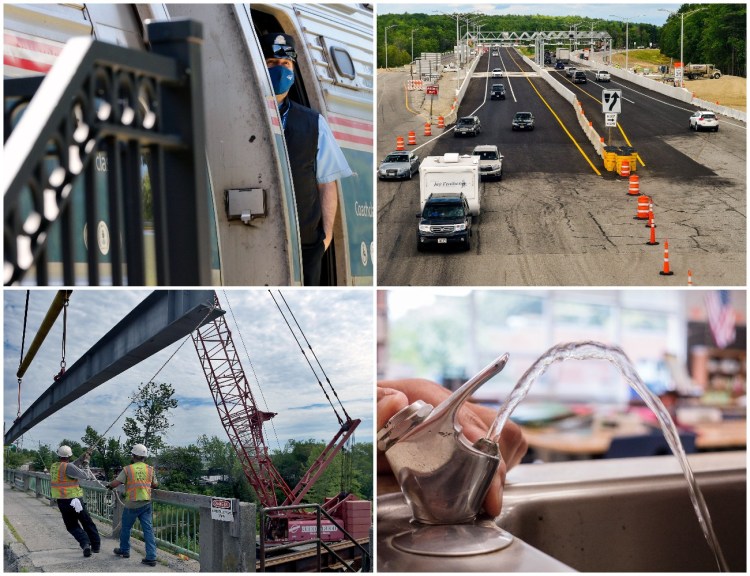Maine is steps closer to receiving billions of dollars in dedicated funding for roads, bridges, water systems, high-speed internet, electric vehicle charging and other programs following the passage of a bipartisan infrastructure bill in Congress last week.
The trillion-dollar package includes about $2.37 billion over five years in direct funding for Maine to repair and rebuild battered infrastructure in the state, according to an estimate by the White House in August.

More money will help address a backlog of work on highways, bridges, water and sewer pipes and other physical structures Mainers rely on every day. Maine’s infrastructure received a C-minus on the American Society of Civil Engineers’ 2020 report card.
The infrastructure funding also includes at least $100 million for broadband internet expansion, at least $19 million to expand a state network of electric vehicle charging stations and more than $230 million for public transportation.
“This once-in-a-generation investment will allow us to fix our roads and bridges, expand high-speed broadband, improve access to clean drinking water, and build a cleaner, more sustainable transportation network – all while putting Maine people to work in good-paying jobs,” Gov. Janet Mills said in a statement.
Federal funding comes just as public agencies contend with skyrocketing construction costs tied to labor challenges and supply shortfalls.
Maine is destined to receive about $1.3 billion alone in regular federal disbursements for highway maintenance and construction, called “formula funding.” The state’s highway program is chronically underfunded and has had to cancel or scale back work in recent years because of escalating costs.
“That is a roughly 25 percent increase, which couldn’t come at a better time because we have had fairly significant increases in the cost of construction,” Transportation Commissioner Bruce Van Note said in an interview.
The bill also includes about $225 million for bridges and $74 million for the state’s airports.
Dedicated funding will restore potholed roads and replace deteriorating bridges, patching together the infrastructure that exists.
But tens of billions of dollars in the bill are dedicated to competitive grant programs that states can chase, part of a program that has received less attention than the dedicated funding for states.
Rules likely won’t be released until next year, but Maine intends to apply for the greatly expanded suite of grants, Van Note said. It is especially interested in funding for a village-focused “complete street” transportation program to emphasize pedestrians, cyclists and other nonvehicular traffic in more populated areas.
“I think these grant programs are making a significant new change,” Van Note said. “I think our next work plan is going to have a lot of things that we haven’t (had) before. We are never going to lose our rural mobility core mission, but I think it will allow some other types of investments that will be game-changers.”
Clean water is set to receive the second-highest amount of funding after highways in Maine, with $390 million dedicated to water infrastructure.

The American Society of Civil Engineers estimates that maintaining Maine’s drinking water systems will require $59 million a year over the next two decades. 2016 photo by Brianna Soukup/Staff Photographer
In 2020, the Maine Chapter of the American Society of Civil Engineers estimated that maintaining the state’s drinking water systems will require $59 million a year over the next two decades.
Maine’s sewer systems need at least $1 billion and likely much more over the next decade, according to a state Department of Environmental Protection survey last year.
Given those infrastructure challenges, new money is welcome but won’t get close to fixing everything, especially with construction prices so high, said Bruce Berger, executive director of the Maine Water Utilities Association.
“We have been so underfunded for the past 30 years, it is getting ridiculous,” Berger said. “We’ve had the need, now we are getting funding, and the materials are 30 weeks out or we can’t get a contractor to do the work. We can’t get the planets to line up, it seems.”
The infrastructure bill also dedicates money to new areas that include broadband internet expansion and electric vehicle charging.
Maine should receive at least $100 million in direct funding for broadband internet expansion. That comes on top of $149 million already designated from the American Rescue Plan Act passed by Democrats in March.
It is the most money Maine’s broadband expansion program has ever received. Thousands of homes in the state do not have access to high-speed internet service, which has hobbled education, healthcare and economic development in some of Maine’s poorest and most rural communities.
More than 200 Maine communities have engaged in some form of broadband development, but projects have been delayed because there was no funding, said Peggy Schaffer, executive director of the ConnectME Authority, tasked with assisting municipal and regional broadband projects. “All that changes now. This is a significant amount of funding that can really move the needle on getting most everyone connected in Maine.”
This spring, the Legislature created the Maine Connectivity Authority to oversee broadband spending and expansion.
“Communities will continue to need to be engaged in this effort for this to really reach everyone with an affordable, high-quality service,” Schaffer said.
Efficiency Maine, the agency responsible for expanding public access to electric vehicle chargers, is likely to get $19 million for that purpose from the infrastructure bill.
That could double the 130 high-speed chargers already installed on Maine highways, said Efficiency Maine Executive Director Michael Stoddard.
“Right now, the network comprises some strategically located places along the major highways and just a couple of places once you get north of Augusta,” Stoddard said. “This would really enable us to build out the network in the more rural parts of the state – that would be one of the core priorities.”
Send questions/comments to the editors.




Comments are no longer available on this story